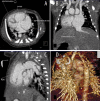Comparison of diagnostic accuracy of dual-source CT and conventional angiography in detecting congenital heart diseases
- PMID: 24987488
- PMCID: PMC4076227
- DOI: 10.12659/PJR.890732
Comparison of diagnostic accuracy of dual-source CT and conventional angiography in detecting congenital heart diseases
Abstract
Background: Cardiac dual-source computed tomography (DSCT) is primarily used for coronary arteries. There are limited studies about the application of DSCT for congenital heart diseases. The aim of this study was to determine the diagnostic value of DSCT in the cardiac anomalies.
Material/methods: The images of DSCTs and conventional angiographies of 36 patients (21 male; mean age: 8.5 month) with congenital heart diseases were reviewed and the parameters of diagnostic value of these methods were compared. Cardiac surgery was the gold standard.
Results: A total of 105 cardiac anomalies were diagnosed at surgery. Sensitivity, specificity, positive predictive value, negative predictive value, and accuracy of DSCT were 98.25%, 97.9%, 98.1%, 99.07%, and 98.2%, respectively. The corresponding values of angiography were 95.04%, 98.7%, 97.8%, 98.1%, and 98%, respectively. Only one atrial septal defect (ASD) and two patent ductus arteriosus (PDA) were missed by DSCT. Angiography missed two ASD and two PDA. DSCT also provided important additional findings (n=35) about the intrathoracic or intraabdominal organs.
Conclusions: DSCT is a highly accurate diagnostic modality for congenital heart diseases, obviating the need for invasive modalities. Beside its noninvasive nature, the advantage of DSCT over the angiography is its ability to provide detailed anatomical information about the heart, vessels, lungs and intraabdominal organs.
Keywords: Angiography; Congenital; Heart Defects; Multidetector Computed Tomography.
Figures




Similar articles
-
Low-dose prospective ECG-triggering dual-source CT angiography in infants and children with complex congenital heart disease: first experience.Eur Radiol. 2010 Oct;20(10):2503-11. doi: 10.1007/s00330-010-1822-7. Epub 2010 Jun 9. Eur Radiol. 2010. PMID: 20532783
-
Accuracy, image quality, and radiation dose of prospectively ECG-triggered high-pitch dual-source CT angiography in infants and children with complex coarctation of the aorta.Acad Radiol. 2014 Oct;21(10):1248-54. doi: 10.1016/j.acra.2014.04.019. Epub 2014 Aug 2. Acad Radiol. 2014. PMID: 25097011 Clinical Trial.
-
Application of prospective ECG-gated high-pitch 128-slice dual-source CT angiography in the diagnosis of congenital extracardiac vascular anomalies in infants and children.PLoS One. 2014 Dec 29;9(12):e115793. doi: 10.1371/journal.pone.0115793. eCollection 2014. PLoS One. 2014. PMID: 25546178 Free PMC article.
-
[The clinical value of computer tomography (CT) of diagnostics of acute thorax pain--a literature review].Przegl Lek. 2013;70(3):123-7. Przegl Lek. 2013. PMID: 24003665 Review. Polish.
-
Diagnostic accuracy of first generation dual-source computed tomography in the assessment of coronary artery disease: a meta-analysis from 24 studies.Int J Cardiovasc Imaging. 2011 Jul;27(6):755-71. doi: 10.1007/s10554-010-9690-4. Epub 2010 Sep 21. Int J Cardiovasc Imaging. 2011. PMID: 20857200 Review.
Cited by
-
Observer variability in the assessment of CT coronary angiography and coronary artery calcium score: substudy of the Scottish COmputed Tomography of the HEART (SCOT-HEART) trial.Open Heart. 2015 May 19;2(1):e000234. doi: 10.1136/openhrt-2014-000234. eCollection 2015. Open Heart. 2015. PMID: 26019881 Free PMC article.
-
Comparison of Image Quality, Diagnostic Accuracy and Radiation Dose Between Flash Model and Retrospective ECG-Triggered Protocols in Dual Source Computed Tomography (DSCT) in Congenital Heart Diseases.Pol J Radiol. 2017 Feb 28;82:114-119. doi: 10.12659/PJR.899876. eCollection 2017. Pol J Radiol. 2017. PMID: 28344686 Free PMC article.
References
-
- Flohr TG, McCollough CH, Bruder H, et al. First performance evaluation of a dual-source CT (DSCT) system. Eur Radiol. 2006;16:256–68. - PubMed
-
- Schardt P, Deuringer J, Freudenberger J, et al. New x-ray tube performance in computed tomography by introducing the rotating envelope tube technology. Med Phys. 2004;31:2699–706. - PubMed
-
- Luo F, Liu C, Zhu Y, et al. Study on the accuracy of dual source computed tomography coronary angiography in detection of coronary artery stenoses in old patients. Sichuan Da Xue Xue Bao Yi Xue Ban. 2010;41(6):1029–33. - PubMed
-
- Cheng Z, Wang X, Duan Y, et al. Low-dose prospective ECG-triggering dual-source CT angiography in infants and children with complex congenital heart disease: first experience. Eur Radiol. 2010;20(10):2503–11. - PubMed
LinkOut - more resources
Full Text Sources
Other Literature Sources
